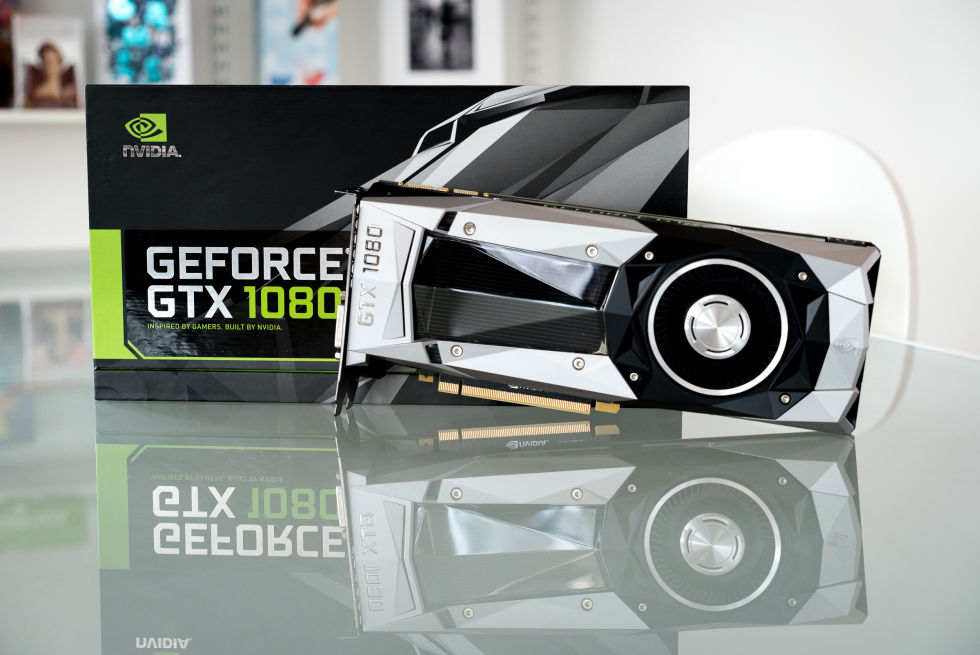
| Specs at a glance: Nvidia GTX 1080 | |
|---|---|
| CUDA CORES | 2560 |
| TEXTURE UNITS | 160 |
| ROPS | 64 |
| CORE CLOCK | 1607MHz |
| BOOST CLOCK | 1733MHz |
| MEMORY BUS WIDTH | 256-bit |
| MEMORY SPEED | 10,000MHz |
| MEMORY BANDWIDTH | 320GB/s |
| MEMORY SIZE | 8GB DDR5X |
| Outputs | 3x DisplayPort 1.4, 1x HDMI 2.0b with support for 4K60 10/12b HEVC Decode |
| Release date | Founders Edition: May 27 |
| PRICE | Founders Edition (as reviewed): £619, €789, $699; Partner cards priced at $599 (probably £450 in the UK) |
The GTX 1080 (buy here) should be a generational leap. Like the Titan before it, this release should redefine consumer graphics card performance—and in many ways, that seems to be the case. Yes, the GTX 1080 is the new world's fastest graphics card, and yes, it's faster than the likes of the now-redundant GTX 980 Ti and Titan X by as much as 35 percent in real-world use. Compared to the 980, in fact, it's faster by as much as 62 percent. For those that want the very best graphics card right now, the 1080 is it.
Still, it's hard to shake the feeling that the GTX 1080 could have been so much more.
The are plenty of innovations here. The 1080 is the first graphics card based on Nvidia's new Pascal architecture, the first with GDDR5X memory from Micron, and the first to be manufactured on a smaller, more efficient TSMC 16nm FinFET manufacturing process. Despite this, the 1080's performance gains aren't entirely unheard of. The 680 was roughly 30 percent faster than the 580, as was the 780 over the 680. The latter didn't even feature a brand new manufacturing process.
Worst of all, however, is the price. Nvidia has jacked up the cost of the 1080 (and the upcoming 1070) by £35/$50 more than the previous generation while also introducing a frankly ludicrous £188 premium for its reference cards (now dubbed "Founders Edition"). These cards will be the only ones available at launch on May 27. US folks get off lightly with a mere $100 price hike.
This is the sort of price rise that only a company without competition could get away with. If AMD's Fury range had fared better, perhaps Nvidia might have pushed the 1080 further or been more aggressive on price. After years of promises, isn't it about time we had a single GPU card capable of playing high-settings games above 30FPS in 4K?
As such, 1080 is the latest in a long line of impressive, if predictable updates from Nvidia. For many—particularly those still rocking a 680 or a 780—the performance improvements in the 1080 will be more than enough to justify a purchase. But for the graphics nerds out there, myself included, it's hard not to be just a tiny bit crestfallen by the jump to 16nm.
Just what the heck is a Founders Edition?
Nvidia confused many with the introduction of the Founders Edition cards at the 1080's Austin outing, but in reality Founders Edition is simply a new name for reference cards that have been slapped with a higher price tag. Nvidia says the higher price goes towards an upgraded five-phase power supply and the (admittedly gorgeous) vapour chamber shroud that looks likes it's been crafted out of shards of aluminium and glass.
The reference redesign was long overdue given the previous design debuted with the Titan back in 2013. But despite Nvidia's protests, the Founders Edition price rise is what it is: an early adopter tax. If you want a 1080 on launch day (or very likely the upcoming 1070 too), Nvidia is milking its brand power and charging a cool £619/$699 for privilege. Cheaper cards from partners like Asus and EVGA will arrive with custom coolers and designs at a later date.
-
The GTX family.
-
-
-
The GTX 980 on the left and the GTX 1080 on the right.
-
The GTX 980 intake on the bottom and the GTX 1080 on top.
-
The GTX 1080 (bottom) has impressive efficiency compared to its predecessors.
-
-
Those partners will have reference designs to go at launch, too, so you're not restricted to buying directly from Nvidia. But it's something of a burn for longtime fans to charge more for them, even if reference cards have typically been sold under razor-thin margins in the past. On the plus side, the Founders Edition will be available over the lifetime of the 1080 rather than just at launch, which is a boon for those who prefer the sharp looks and blower-style design of the reference card.
Thanks to the more efficient manufacturing process as well as improvements to the Pascal architecture, the 1080 doesn't need as much power or cooling as previous generation cards. Thus, the typically noisier blower design becomes far more appealing. There's a single eight-pin power connector at the rear of the 1080, which feeds its TDP of just 180W. Considering the 1080 is faster than both of the 980 Ti and Titan X, which pull out 250W, that's an impressive improvement to efficiency.
reader comments
300